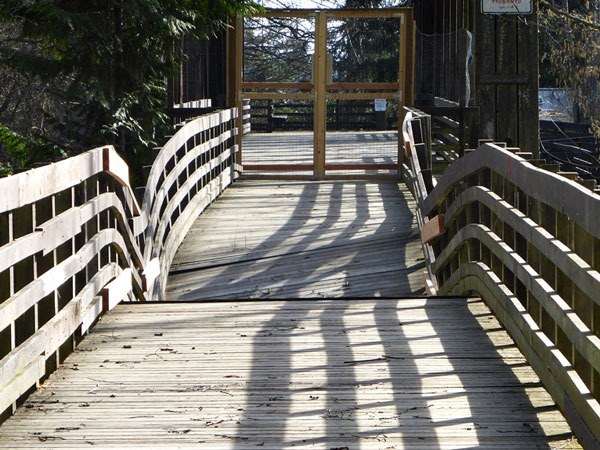by ALANA LINDEROTH
Sequim Gazette
Permenant repair or reconstruction to the trestle at Railroad Bridge Park isn’t likely to occur in the near future.
“Best scenario would be construction begins next summer… that would be my guess,” Scott Chitwood, natural resources director for Jamestown S’Klallam Tribe, said.
Flood conditions in early February urged the Dungeness River to shift from its main channel into a more western channel and erode six pilings from the river bottom allowing them to break away from the remaining structure and a portion of the deck to collapse.
Although the trestle is stabilized and the bridge portion is open to the public, but not to through traffic, the cost of repair remains unknown.
“We have completed the inspection necessary for the insurance,” Annette Nesse, chief operating officer for the Jamestown S’Klallam Tribe, said. “We’re still waiting to see the level of insurance coverage.”
The 600-foot trestle in combination with the 150-foot bridge span the gap across the river to either side of its floodplain, equating to about 750 feet across, Chitwood said.
“Based on the assessment of the pilings, I don’t think any engineer would be happy with a Band-Aid,” Chitwood said. “The pilings aren’t in good shape and haven’t been updated since 1958. It’s just a question of time as to when the rest of the trestle isn’t usable or safe.”
To fully replace and repair the aging trestle would require the equivalent of four Dungeness Bridges, but about a 150-foot section needs to be built to address the damaged section only and possibly allow access across the new channel.
“This could be a temporary fix, but really we’re looking at 600 feet in need of fixing,” Chitwood said. “There’s been some talk about getting a temporary bridge up for events.”
The trestle owned by the Jamestown S’Klallam Tribe is insured, but the deductible is “rather large,” he said.
“We’re probably talking about a couple million dollar project,” he said. “The design and engineering work hasn’t been done yet, but everyone seems to have the sense it’s going to be a pretty big price tag.”
Officials with the tribe are working on a funding scheme, Chitwood said, and are exploring various options including possible funds from North Olympic Peninsula Lead Entity or re-obligating funds from Floodplains by Design. Because the park is privately owned, federal and/or state financial support may be sought, but not a given.
Chitwood isn’t directly involved with the effort to address the trestle, but said he knows “the tribe is doing everything
it can to find a solution.”
Until the bridge is reopened, Olympic Discovery Trail users can take two alternative routes, Jeff Bohman, president of the Peninsula Trails Coalition, said – either the southern route along U.S. Highway 101 or the northern alternative along Old Olympic Highway.


